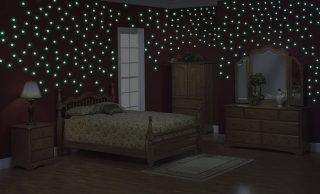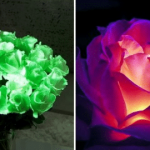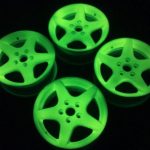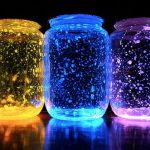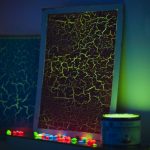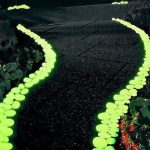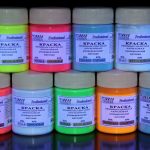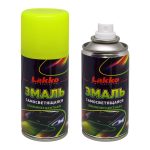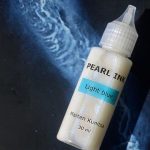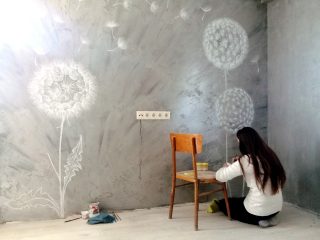Luminous paints have long ceased to be produced only in bright phosphoric color. Modern luminescent pigments are safe formulations offered by manufacturers in more than 10 shades. They can be used in a variety of areas of creativity and design. But to get a good result, you need to understand how they work, how to use them correctly.
Description and material properties
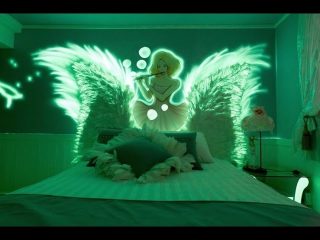
Fluorescent and luminescent paints consist of phosphors - materials that can react to sunlight and ultraviolet light. After the accumulation of rays, they acquire a bright glow and volume.
Many luminous pigments are capable of gain energy in 15 minutesand then gradually give it back within 10-12 hours... The addition of colors to phosphors changes the effect and hue of the painted surface.
It is accepted to separate fluorescent and luminescent paints... The second includes paint and varnish material that glows in the dark after the accumulation of sunlight. Luminescent pigments have a strong glow and illuminate the surrounding surface.
Other properties:
- after hardening, they form a perfectly flat surface;
- pigment size 5 microns;
- resistance to moisture, frost;
- service life up to 30 years;
- environmental friendliness and safety for health.
Fluorescent formulations do not accumulate light, but activated by ultraviolet radiation... On the contrary, under the sun's rays, they burn out and collapse.
Scope of application
Luminescent pigments are used to solve the following tasks:
- decor of ceilings, walls and floors in residential and public areas;
- drawing bright signs and road markings;
- creation of unusual floristic compositions and bouquets;
- painting furniture and decor;
- creation of souvenirs, art compositions;
- production of scenery, stage costumes, make-up;
- painting gazebos, fences and other structures when decorating garden plots;
- painting bicycles, cars and motorcycles;
- production of workwear for road and emergency services;
- production of advertising products.
It is possible to use luminescent compositions in other areas, because there are no restrictions on their compatibility with materials.
Varieties of paints
Some of its characteristics and ease of use depend on the type of dye.
By composition
According to the composition, 3 types of luminescent paints can be distinguished:
- Acrylic... Water-based paint, odorless. Suitable for indoor use as well as outdoor use. It dries quickly, is not afraid of moisture and temperature extremes.
- Inert enamel... Made on a polyurethane base. For indoor use, different colors can be mixed. Perfectly fits over wood, plasterboard and plaster. It has high strength and is often used in specialized areas: road finishing, workwear creation.
- Ink... They are used in interior printing, in the creation of advertising products, in art and design. You can use UV-only fluorescent inks.
By release form
The funds are produced mainly in three types:
- Spray can... Sold in cylinders. The composition includes an acrylic base. It is used to work on large areas.
- Powder... Dry added to common paints.
- Liquid paint in cans... Sold in small containers for creative work.
When creating one project, you can combine different forms of production of luminescent paints.
How to choose the composition and color
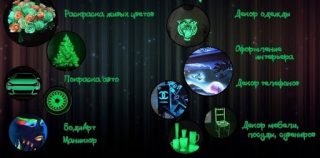
The choice of the type of paint depends on what it will be used for:
- if processed will be big square - walls, furniture, car surfaces or the entire bicycle frame, - pick up the composition in spray cans;
- if you need to cover small partthen choose liquid paint in jars;
- while creating complex large patterns you can use pigments in buckets, applying them with paint brushes and rollers;
- for the paint used on skin and clothing, there is one requirement - a safe water base;
- to cover plastic, you should choose special polyurethane-based enamels;
- if needed high quality paint, then when buying, you should familiarize yourself with the certificate from the seller.
The choice of color for luminescent paints is limited. Most manufacturers offer 8-10 base tones. However, they can be mixed to create original combinations.
If you want to combine different shades, it is important to remember that it is unacceptable to combine compositions from different manufacturers.
There is another parameter when choosing a color - glow intensity. Achromatic shades under the influence of ultraviolet radiation become saturated and bright, and without it they are invisible to the eye. Chromatic colors, under the influence of rays, become very bright.

Recommendations for use
In order for the coating to serve for a long time and always please with a fabulous glow, it must be correctly applied to the surface. All manufacturers provide precise recommendations for the use of products on labels and packaging.
Preparatory work

Before painting any surface, you need to prepare it:
- the wood is sanded to create a flat surface;
- plaster, whitewash and other coatings are completely erased;
- dirt is removed with a scraper, and then cleaned with a cloth or sponge with soapy water;
- oily surfaces can be cleaned with alcohol or baking soda solution.
After removing contaminants, be sure to rinse again with plain water and allow to dry completely. Then they apply a thin acrylic primer coatto improve adhesion and reduce the consumption of fluorescent products.
Application rules
Then they start applying the product:
- when using spray cans, stencils and limiters can be used;
- liquid formulations are applied to large surfaces with a roller, pouring the product into a cuvette;
- it is enough to carry out over the surface once to create an even layer;
- you can use a spray gun to paint large areas;
- use a sponge to create transitions, gradients and other effects.
Among the luminous compositions, phosphorescent ones, consisting of phosphorus, should be avoided. They can only be used where the person is not constantly in contact with the pigment.

